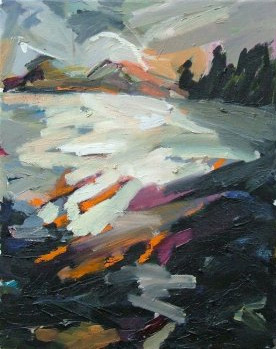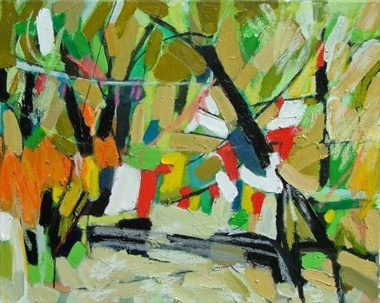
| HOME |
| NERVE |
| REVIEWS |
| ARCHIVE |
| EVENTS |
| LINKS |
| ABOUT US |
| CONTRIBUTORS |
| BACK ISSUES |
| CONTACT US |
 Colin
Taylor - New Work
Colin
Taylor - New Work
Wendy J Levy Gallery, Didsbury
8th June – 2nd July 2011
Reviewed by Sandra Gibson
Whereas Colin Taylor’s previous exhibition at the Anglican cathedral in Liverpool depicted his experience of the cathedral space in chalk, graphite, charcoal and cast iron powder - media he said best suited his need to make strong, unimpeded contact - the artist’s recent exhibition New Work is predominantly in colour using oil and pastels with some charcoal for definition and his subject matter is mainly exterior landscape, including townscapes.
The pictures are full of vibrant life painted with a directness and sureness of touch that convinces you that the paint is not yet dry. What is there is a feeling of tumultuous geological power; a sense of possibility in a torrent of glacial water which may solidify to ice or flow faster and faster in the pale sunlight; a glimpse of vast, unvisited spaces and more space beyond; an instinctive balance between areas of light and dark; a celebration of a distinct momentary colour palette and an intimation that we have shared one moment and that now everything has moved on.
In forcing the representational artist to reconsider his position – in more ways than one - the camera revolutionised art in a way impossible to understand from the perspective of our networked exhibition of the minutiae of our existence. Released from creating an illusion of a ‘recognizable’ scene viewed within the pictorial framework, the artist could experiment with scale, explore the emotional potential of colour, abandon perspective, introduce multi-directional view points, deliberately - or unconsciously - include ambiguity and generally maul the viewer’s expectations.
In other words, the artist became free to examine the interior world of his own thoughts and feelings - to chart his own passionate journey. Colin Taylor doesn’t aim for a technically accurate duplication of place; he wants to recreate the actual experience he had – this is what he means when he says, “my work is not an optical expression, but an emotional one.”
Just as he can convey the tumbling bulk of building or cliff or mountain or torrent he can also capture an instant of repose, where the stillness of the space resembles a momentary glimpse of a stained glass window. The same feeling of stillness/rightness is achieved by the balancing of the composition by light and dark areas or echoing slabs of colour. The experience of the fleeting moment is conveyed in paintings where the same scene such as Agouti or Bassenthwaite or Sidi Chamarouch has been painted more than once, the time lapse creating changes in palette and light and mood.
In the light of this pre-occupation Colin Taylor is keen to have charcoal to hand – he calls it a “go-to tool”, a fast medium with which to catch the moment. He also likes pastels but there is an interloping time during which a colour is selected and as for paint – there is all that selecting of colour and unscrewing of tops and squeezing out of pigment getting in the way…
 Yet,
despite the emphasis on the immediate and the freshness of the brush strokes
and the dynamic lines of charcoal, the reverse side of a canvas may reveal
a secret: the dates the artist has revisited and altered his painting.
“I don’t subscribe to a totally defined work,” he says.
Yet,
despite the emphasis on the immediate and the freshness of the brush strokes
and the dynamic lines of charcoal, the reverse side of a canvas may reveal
a secret: the dates the artist has revisited and altered his painting.
“I don’t subscribe to a totally defined work,” he says.
Why is there so little figurative content in his work? Do the wild regions which inspire him make man seem insignificant? “It’s not about the scalability of me and it – it is about the experience of being there. The climbing releases emotions and you do feel that it’s a different world up there. I have no socio-political comment to make, either, though teaching people to climb I do have a vested interest in the environment being kept clean. Nor does the landscape overpower me as an artist. I am unafraid to express the power of nature. As for figures – I haven’t learnt to do that yet.”
No I’m not a spiritual person – I don’t think I am.”
And if he hasn’t learned to do that yet there is ample evidence of man’s presence in these paintings. Look at the directional vigour in the charcoal drawing of Brooklyn Bridge; look at the multidirectional jarring of the Great Wall of China and the debris of disturbance in Khuiten Base Camp.
The artist has stopped short of abstraction although looking at the Agouti trio and the two paintings of Sidi Chamarouch and the Windermere paintings he treads a fine line and you have to look carefully at Brolleyfield in Beijing to discern the figures.
In Colin Taylor we have a landscape artist who is unafraid to experience and express the power of nature and natural forces. Like Turner he is prepared to be strapped to a mast during a storm. His work is heroically beautiful.
Take a walk on the wild side – you only have to go as far as Didsbury!